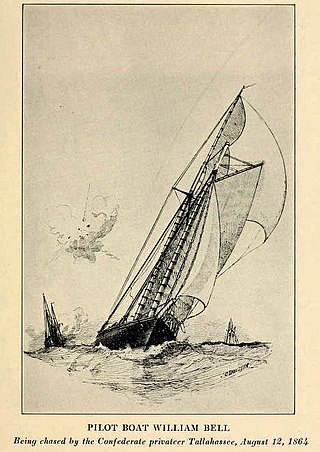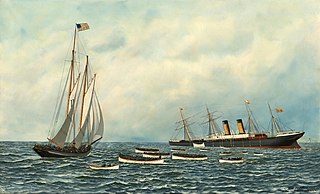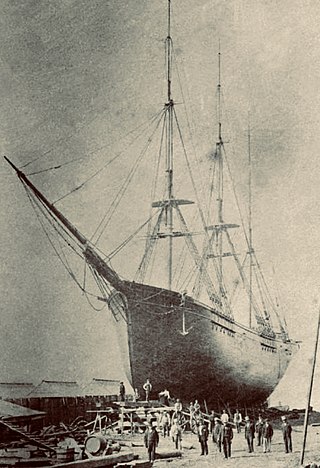
The William Bell was a pilot boat built in 1864 by shipbuilder Edward F. Williams at Greenpoint, Brooklyn for a group Sandy Hook Pilots. She was captured and burned by the Confederate raiding steamer CSS Tallahassee during the American Civil War. A second William Bell was constructed in 1864-1865 to replace the first one.
Isaac Webb, was a 19th-century shipbuilder, owner and founder of the Isaac Webb & Co. shipyard. He was one of the founders of shipbuilding in the United States.

The Isaac Webb was a 19th-century Sandy Hook pilot boat built in 1860 by Webb & Bell for the New York and Sandy Hook pilots. She received a reward by the Board of Pilot Commissioners of New York for saving three sailors from the wreck of the bark Sarah, that was caught up in a hurricane. The Webb was shipwrecked in a dense fog at Quonochontaug Beach, Long Island in 1879. She was replaced by pilot boat Columbia.

The Phantom was a 19th-century Sandy Hook pilot boat built in 1867 from the designs by Dennison J. Lawlor. The schooner was considered a model for her type with a reputation for being very fast. She helped rescue the passengers on the steamship SS Oregon when it sank in 1886. She was one of the pilot-boats that was lost in the Great Blizzard of 1888. The Phantom was replaced by the pilot-boat William H. Bateman.

The Washington was a 19th-century Sandy Hook pilot boat built in 1845 by C. & R. Poillon for New York Pilots. She was rebuilt several times, the last with the sail number "22" painted on her mainsail. In 1884, she was sunk by the German steamship Roma, and then replaced by a new Washington.

The Jesse Carll was a 19th-century pilot boat, built in 1885 by Jesse Carll at Northport, New York, for George H. Sisco. She was one of the largest vessels ever built in the Sandy Hook service. She was named in honor of Jesse Carll, a well-known Northport shipbuilder. In 1896, in the age of steam, the Ezra Nye, along with other pilot boats, were replaced with steamboats.
The David Mitchell was a 19th century Sandy Hook pilot boat built in 1846 at Baltimore, Maryland, for a group of New York Pilots. She was launched at the John A. Robb shipyard in East Baltimore. She was sold to the Pensacola, Florida pilot fleet in 1875.
The James Avery was a 19th century Sandy Hook pilot boat built in 1837 for a group of New York Pilots. She was built by the shipbuilder Jacob Bell. The James Avery was a pilot boat during the American Civil War that helped in the search of the Confederate CSS Tallahassee. She was last seen in 1872, off the Highlands.

The Christian Bergh was a 19th-century Sandy Hook pilot boat built in 1851 at the Westervelt & Co. shipyard. She later became a Pennsylvania pilot boat until her service ended in 1886 when she became an oyster boat in the Delaware Bay. She was named after Christian Bergh a prominent shipbuilder in New York and a close friend of Jacob Westervelt.
The Mary Ann, No. 13 was a 19th-century Sandy Hook pilot boat built for the New York pilots. She helped transport maritime pilots between inbound or outbound ships coming into the New York Harbor. In 1860, the Mary Ann, was one of only twenty-one pilot boats in the New York and New Jersey fleet. She went ashore outside Sandy Hook in 1863.

The Thomas H. Smith, or T. H. Smith, was a 19th-century Sandy Hook pilot boat built for the New York pilots around 1820. She helped transport maritime pilots between inbound or outbound ships coming into the New York Harbor. In 1840, she was one of only eight pilot boats in the New York fleet. In 1857, she went ashore and sank six miles from Barnegat.

The Centennial was a 19th-century wood pilot boat built in 1876 by Robert Crosbie and designed by Boston designer Dennison J. Lawlor for New York and New Jersey pilots. She was one of the pilot-boats that survived the Great Blizzard of 1888. By 1898, in the age of steam, she was the last pilot boat left in the fleet; then sold in 1898 to a group in Montego Bay, Jamaica.

The David Carll was a 19th-century pilot boat, built in 1885 at the David Carll shipyard in City Island, New York. She was named in honor of David Carll, a well-known City Island shipbuilder. The David Carll was considered to be among the fastest schooners in the fleet. She was built to replace the Mary E. Fish that was run down and sank by the schooner Frank Harrington in 1885. She was one of the pilot boats that survived the Great Blizzard of 1888. The David Carll was lost at sea in 1893.

Edward Francis Williams, was a 19th-century shipbuilder. He apprenticed under his father Jabez Williams. Edward F. Williams built his own shipyard, building clipper ships and eleven Sandy Hook pilot boats, some of the finest boats in the fleet. He was the first president of the Greenpoint Savings Bank. Williams died in New Providence, New Jersey, in 1902.
The Blossom was a 19th-century Sandy Hook pilot boat built for the New York pilots around 1837. She helped transport maritime pilots between inbound or outbound ships coming into the New York Harbor. In 1839, she came across the Slave ship La Amistad. In 1840, there were only eight New York pilot boats, the Blossom being No. 5. Pilot Thomas Freeborn of the Blossom boarded the packet ship John Minturn and tried to guide the ship in bad weather. He was one of thirty-eight passengers that died near the Jersey Shore in 1846.

The Joseph N. Lord was a 19th-century Sandy Hook pilot boat built in 1840 at the Jabez Williams shipyard in East River, for New York pilots. She helped transport maritime pilots between inbound or outbound ships coming into the New York Harbor. The Joseph N. Lord was lost at sea in 1845 at Port-au-Platt, Dominican Republic.

The Virginia was a 19th-century Sandy Hook pilot boat. She came from Savannah to New York City in 1838. In 1840, the Virginia was No. 8 in the list of only eight pilot boats in the New York fleet. She went ashore in 1860 and was replaced by the pilot boat William H. Aspinwall in 1861.
The E. K. Collins was a 19th-century Sandy Hook pilot boat built in the early 1840s. She was named for the American shipping magnate Edward Knight Collins. During a winter storm, the Collins ran ashore on the outer bar of Fire Island in 1856.

The James W. Elwell was a 19th-century two-masted Sandy Hook pilot boat, built in 1867 by John A. Forsyth at Mystic Bridge, New London, Connecticut for New Jersey and Sandy Hook maritime pilots. She raced for a $1,000 prize at the Cape May Regatta in 1873. She went ashore and was shipwrecked on North Beach Haven, New Jersey in 1875.

Thomas D. Harrison was a 19th-century New York pilot boat built for New Jersey pilots. She was launched from the Jacob S. Ellis & Son shipyard, at Tottenville, Staten Island in 1875. The Harrison went ashore in the Great Blizzard of 1888 with no lives lost. She continued as a pilot boat with Pilot Stephen Cooper in command. She was purchased in 1897 by Allerton D. Hitch and used for coastal trade in the Cape Verde islands off the west African coast.














